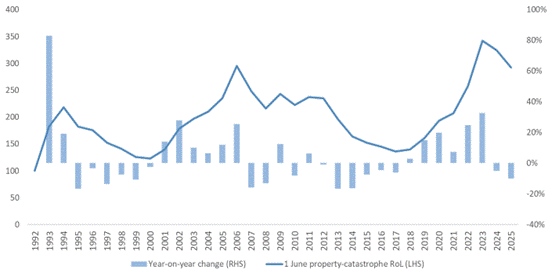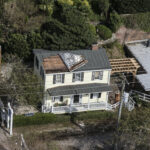Property-catastrophe reinsurance pricing saw continued moderation at the June 1 renewals with a selective return of capacity following historic pricing strength, according to Howden Re, the reinsurance and advisory arm of Howden.
While rate moderation continued and reinsurers’ appetite expanded, “underwriting rigor persisted, especially in structurally challenged layers,” said Howden Re’s June 1 renewal report.
Risk-adjusted rate-on-line changes ranged from flat to down 20%, depending on loss experience and attachment point, the report said, noting that, despite pricing pressures, programs generally attracted subscriptions above 100%.
Renewals in Florida were marked by increased appetite from traditional reinsurers, which appeared confident in litigation reforms and viewed pricing as attractive after years of caution, the report indicated.

Property-Catastrophe XoL
In the property-catastrophe excess-of-loss (XoL) reinsurance market, capital inflows have rebounded, with newly formed reinsurers and syndicates deploying meaningful capacity into mid-year placements, the report confirmed.
“As such, expanding supply continues to outpace rising demand, underpinned by improved reinsurer retained earnings and sustained catastrophe bond activity, including the issuance of new and upsized transactions at the upper layers of reinsurance programs,” Howden Re continued.
As a result, the broker said, remote-attaching cat-XoL layers have experienced rate reductions in the range of 10% to 20%.
Blended risk-adjusted property-catastrophe XoL rates-on-line were down 10%, with loss free programs down 10% to 15% on a weighted average basis, the report said.
“The dynamic this year was neither a continuation of 2023’s dislocation nor a broad softening. Rate levels remain historically high but are now outpacing loss trends in many areas,” said Kyle Menendez, managing director, Howden Re, North America, in a statement. “This is drawing more interest from markets, including Lloyd’s syndicates with previously cautious balance sheets looking to grow incrementally.”
Layered Outcomes
Howden Re said outcomes for buyers were mixed across towers with top layers experiencing the most competitive pricing, with some rate reductions greater than average as a result of surplus capacity from the insurance-linked securities sector.
“Cedents purchasing multiple layers or products on a concurrent basis found greater support from reinsurers willing to underwrite holistically rather than transact tactically,” the report said, explaining that reinsurer support extended to property per-risk XoL placements, alongside a resurgence in aggregate or second and third event covers.
“In addition to traditional occurrence protection, cedents are evaluating, and increasingly attracting, capacity for sideways and aggregate structures, as reinsurers respond to heightened cedent demand for coverage that addresses the frequency of catastrophe events,” Howden Re said.
Brian McKeon, managing director, Howden Re, commented: “Reinsurers are being deliberate. We’re seeing evidence of measured growth, especially from those carriers that had stepped back in recent years. More reinsurers support full programme structures, especially where multiple property products are purchased at the same inception date, in the hope of influencing catastrophe occurrence signings.”
Florida Finds Stability With Legal Reforms
Reinsurers underwriting in Florida appear confident in legal reforms, said Howden Re, noting that assignment of benefits (AoB) restrictions and litigation reforms have broadly held, with attempts to reverse them largely unsuccessful.
As a result, Howden Re added, this stability has reinforced continued, selective appetite for Florida risk. “Despite price softening, demand growth has absorbed new capacity. Significant additional limit was sought by buyers amid Citizens’ continued depopulation and the launch of several new domestic carriers.”
A 20% increase in retention levels from the Florida Hurricane Catastrophe Fund (FHCF), projected at $11.3 billion for 2025, drove cedents to seek private market solutions for lower layers, Howden Re said.
The report explained that pressure on rates at these levels was largely mitigated by increased appetite from traditional reinsurers which now view them as attractive after years of caution.
“Capital is now more abundant and increasingly diverse, yet it’s being deployed with discipline, especially below the FHCF where pricing remains firm,” noted David Flandro, head of industry analysis and strategic advisory, Howden Re. “At the top of towers, ILS are providing flexibility and competitive tension, marking a shift from crisis to calibration. This is a function of a stabilizing market.”
Topics Property
Was this article valuable?
Here are more articles you may enjoy.



 Applied Systems, Comulate Spar Over Trade Secret Theft Allegations
Applied Systems, Comulate Spar Over Trade Secret Theft Allegations  How ‘Super Roofs’ Reward Insurers, Cat Bond Investors and Homeowners
How ‘Super Roofs’ Reward Insurers, Cat Bond Investors and Homeowners  Product Liability Verdicts Are on the Rise but There Are Ways to Avoid Them
Product Liability Verdicts Are on the Rise but There Are Ways to Avoid Them  In Alabama, Shot Employee Gets No Workers’ Comp and No Employer’s Liability
In Alabama, Shot Employee Gets No Workers’ Comp and No Employer’s Liability 

